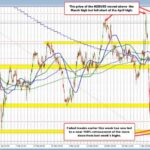
Tulsi Gabbard’s Game-Changing Announcements on Election Security and Transparency
Tháng 4 11, 2025
Navigating the NZD/USD Rebound: Key Insights and Market Dynamics
Tháng 4 11, 2025Here’s the content with the relevant backlink incorporated:
Analyzing Recent Trends in U.S. Treasury Yields: Key Factors at Play
Recent developments in the U.S. Treasury yield curve have captured the attention of investors and economists alike, revealing a significant upward trend across all maturities. This notable increase in yields can be traced back to several interrelated factors, each playing a crucial role in shaping market dynamics.
The Influence of Tariffs on Treasury Yields
One of the foremost drivers of rising Treasury yields has been the implementation of new tariffs, raising apprehensions about a potential drop in foreign demand for U.S. debt instruments. As tariffs took effect, the immediate market response was a sharp spike in Treasury yields, affecting both short-term and long-term notes. Investors began to speculate that reduced foreign investment in U.S. debt could lead to an oversupply, forcing yields higher. This shift has caused a ripple effect throughout global bond markets, with other nations closely monitoring the changes made by the U.S. government and adjusting their positions accordingly. This backdrop is further complicated by rising tensions in U.S.-China relations, as outlined in the analysis of China’s strategic moves by President Xi Jinping.
Understanding the Yield Curve Dynamics
In a significant reflection of growing economic uncertainty, the U.S. Treasury yield curve has steepened considerably in recent weeks. The 2-year Treasury yield has surged to approximately 3.91%, while the 30-year yield experienced a remarkable rise to 4.74%, even briefly surpassing the 5% threshold amid heightened market volatility. This steepening of the curve often signals investor concerns regarding future inflation and economic stability, suggesting that longer-term risks are becoming increasingly pronounced in the eyes of market participants. The divergence in yields is a critical indicator, as it provides insight into how investors perceive the economic outlook—transitioning from short-term liquidity challenges to long-term growth skepticism.
Economic and Trade Tensions Exacerbating Market Volatility
Moreover, the prolonged tensions in U.S.-China trade relations, now marked by tariffs peaking at 145%, have further undermined market confidence. The temporary suspension of some tariffs created initial relief; however, market dynamics quickly shifted back to a bearish sentiment, impacting stocks, bonds, and the U.S. dollar. As tariffs fluctuate and negotiators scramble for an elusive trade agreement, uncertainty continues to loom, complicating investment decisions and creating an unpredictable economic environment.
Volatility: A Reflection of Market Sentiment
The recent surge in Treasury yields serves as a manifestation of heightened anxiety within the markets. This concern has led to an uptick in the Volatility Index (VIX), pointing to increased risk aversion among investors eager to mitigate exposure to fluctuating asset values amid instability. As uncertainty persists, it becomes imperative for investors to navigate these turbulent waters with caution, making informed decisions that acknowledge the interplay between geopolitical events and financial markets.
In summary, the combination of tariff impacts, yield curve dynamics, trade tensions, and increased volatility has created a complex environment for U.S. Treasury yields. As these factors continue to unfold, monitoring their implications will be essential for understanding potential shifts in investment strategies and overall market behavior. Investors must remain vigilant and adaptable, ensuring that their portfolios align with the rapidly evolving economic landscape.
